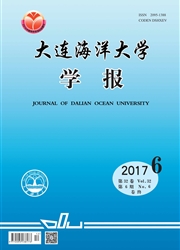

 中文摘要:
中文摘要:
在实验室条件下模拟海产品深加工废水,利用自制纳米TiO2为光催化剂,在紫外光照射下进行光催化氧化海产品深加工废水的研究,考察了催化剂用量、溶液pH、氨氮初始浓度、化学需氧量(COD)初始浓度、光照时间等因素对光催化氧化过程的影响。结果表明:纳米TiO2光催化剂能有效催化降解海产品深加工废水中的氨氮和COD等污染物,其优化处理条件为TiO2添加量0.9 g/L、氨氮初始浓度80 mg/L、COD初始浓度300 mg/L、溶液pH 9、紫外光照射3 h,在此优化工艺条件下,氨氮和COD的去除率分别可达69.76%和73.33%。
 英文摘要:
英文摘要:
The photo-catalytic degradation of seafood processing waste water by nano-titanium dioxide prepared during the experiment was studied in a photo-catalytic system of TiO2with the UV excitation.The effects of different degradation variables on the degradation efficiency were investigated,including amount of catalyst,pH value,initial concentration of ammonia-N and chemical oxygen demand( COD) in seawater,and catalytic reaction time.The results showed that nano-TiO2photocatalyst led to effective degradation of seafood processing wastewater and the pollutants under the optimal conditions for photocatalytic degradation of ammonia-N and COD.It was found that 69.76% of ammonia-N and 73.33% of COD were eliminated under the conditions of 0.9 mg/L of TiO2,catalytic reaction for 3 h,initial ammonia-N of 80 mg/L,initial COD of 300 mg/L,and pH of 9.
 同期刊论文项目
同期刊论文项目
 同项目期刊论文
同项目期刊论文
 期刊信息
期刊信息
